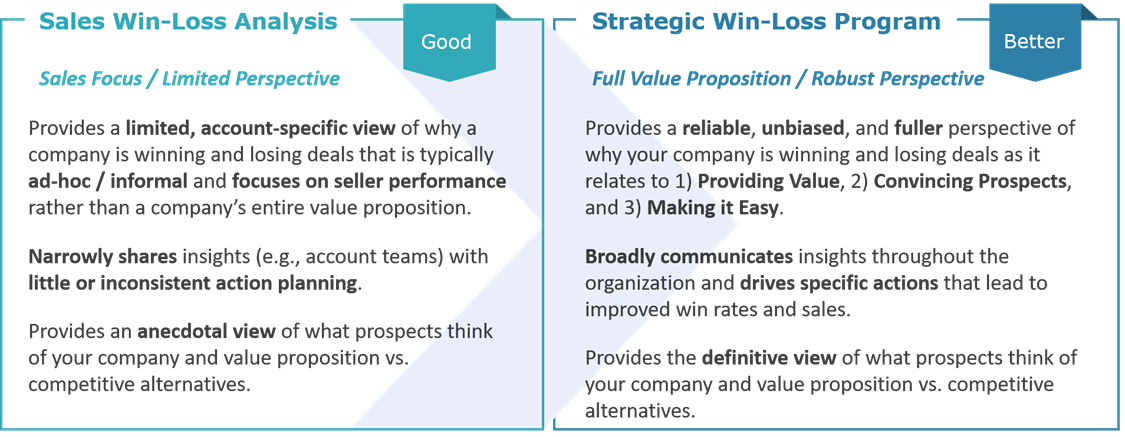A Win-Loss program involves ongoing interviews with decision-makers at prospect companies from a broad sample of won and lost deals to better determine why an organization is winning and losing business, and to whom. Insights from these interviews are used to make improvements and better leverage what an organization is already doing well to improve the client experience, win rates, and ultimately sales performance.
Based on years of Win-Loss experience partnering with companies across a variety of industries, we offer up 4 best practices to improve the ROI of Win-Loss whether you’re just starting out or looking to enhance an existing program.
1. Structure Win-Loss around the Business of Winning Business
Undoubtedly, there is work to be done for any organization that wants to build brand awareness and consideration for its products and services. However, once you are in the consideration set, along with other companies vying for the same opportunity, closing new business fundamentally comes down to three “battlegrounds” (Fig. 1):
Fig.1
“It takes a village” as they say, so your Win-Loss program should be structured around your performance across key aspects of each of these areas. Just as a great salesperson cannot (fully) compensate for a competitively inferior product, a superior solution will underperform if it’s not well positioned by your marketing and sales efforts. Certainly, the buying experience itself also plays a critical role as does pricing and an organization’s commercial terms.
With that in mind, a “Strategic Win-Loss” program, unlike “Sales Win-Loss”, focuses prospect interviews on an organization’s entire value proposition to determine how well it’s performing across all key battlegrounds in the prospect’s purchase journey (Fig. 2). This approach ensures that your Sales, Marketing, Product Development, Pricing, Customer Experience (CX), and Contract organizations all derive value from your Win-Loss investments and pull from the same rope to improve win rates and sales.
Fig. 2
The other advantage of a Strategic Win-Loss program is that it focuses on distilling and communicating these insights across the organization so there is one “single source of the truth” that all stakeholders can buy into and action plan around, not just sales account teams. It also helps galvanize cross-functional teams that all ultimately contribute to sales success (and failure).
2. Dive Deep for Real Insight and Impact
Just because you are casting a wider net across a prospect’s entire purchase journey does not preclude you from diving deep in key areas that uncover real insights. In fact, if you don’t dig into the issues, you are likely missing key opportunities to identify areas where improvement can lead to a better customer experience and more sales. The performance of an organization’s sales professionals is just one example where we commonly see this:
- Typical, High-Level Approach – questions in a Win-Loss prospect interview that examine your sales team’s performance might include:
- To what extent did the XYZ Company’s sales rep contribute to your purchase decision?
- What did he or she do well that influenced whether you thought XYZ Company and their product would be the right choice? What did they not do as well or could have done better?
- What about the sales reps at other companies you considered? What did they do well or not well that influenced your decision?
This approach will yield some insights about sales performance, but taking the interviews a few layers deeper will make what you learn much more specific and actionable.
- Alternative, Deep-Dive Approach – using the same example as above, we typically break the sales process down into key steps so each can be explored more specifically and directly. Examples of questions using this approach might include:
- How would you rate the level of trust and rapport you had/have with the Company XYZ’s sales rep on this purchase occasion on a 1 (poor) to 10 (excellent) scale?
- What did or didn’t they do that contributed to this level of rapport and trust?
- What about other firms you considered – what did their sales reps do or not do that contributed to the rapport and trust you had with them?
From there, a similar set of questions can be asked for other critical steps in the sales process such as understanding prospect needs, presenting valuable solutions, addressing prospect concerns (objections), etc.
It is unlikely there will be time to explore all of these areas, and other dimensions of an organization’s value proposition, to this level of depth in a single Win-Loss interview. The point is, consideration should be given to exploring at least some key areas at a deeper level or even rotating topics you dive deep on at scheduled intervals to get a more comprehensive view over time. Companies that do this are able to identify more specific and prescriptive actions they can take to improve performance.
3. Activate Win-Loss Insights for Impact
Common deliverables produced from Win-Loss interviews include different mechanisms for communicating what was said by prospects (transcripts / audio files) and providing brief summaries of individual opportunities and summary analysis over a certain period of time (e.g., quarterly or semi-annually).
These types of “reporting” mechanisms are a fundamental component to any Win-Loss program because they provide foundational information about what is going on in the market. However, they’re simply not enough. Why? Because, while they do an adequate job of “reporting” what’s going on, they do an inadequate job of activating these insights so they result in improved win rates and sales.
To truly move the needle on performance, each of the following should also be a core component of any Win-Loss Program:
- Win-Loss KPIs – as they say, “you get what you inspect, not what you expect” and if there are no targets set and measured on an ongoing basis then there is no way to monitor how well your improvement efforts are going or to ensure they remain one of the key focal points of the organization. KPIs could be as simple as win rates overall and for high priority segments (e.g., product/service category, geography, customer type), in addition to other financial measures most companies monitor already (revenue, profitability, etc.).
- Online Dashboard – online dashboards that provide (near) real-time information and metrics on wins and losses accomplish two things. First, they provide one “single source of the truth” that stakeholders across the organization can tap into in order to see what’s REALLY going on in terms of wins and losses. Second, they help management keep track of progress against KPIs so they can ignite action when, where, and how it’s needed.
- Activation Workshops – there are different forms and approaches, but activation workshops typically involve getting all key stakeholders in a room to:
-
- Communicate key results from Win-Loss interviews so there is a mutual understanding about what is going on (the “good” and the “bad”)
- Brainstorm potential steps to improve performance
- Select one (or a few) approaches to improve performance
- Identify action steps for top ideas and assign individuals or teams to move them forward
Once the ideas have been fully vetted, a business case is developed (as needed), and those selected are implemented with alignment to Win-Loss KPIs to measure and monitor progress.
- Sales Tools – these typically involve sales assets that are developed based on Win-Loss interviews and complementary inputs. For example, a “Sales Battle Card” is developed that arms an organization’s salesforce with information for how to effectively compete against a particular competitor. These Battle Cards could include things such as common sales tactics used by a particular competitor, how they position themselves, pricing and discount tendencies, etc. They also provide specific recommendations to help prospects see the tangible and differentiating value of your product or service.
- Sales Training – one opportunity often missed is to incorporate learnings from Win-Loss programs into an organization’s sales training. These insights are particularly useful to sales professionals just entering the company because they provide a crash course from the “voice of the prospect” on how to win (and lose) their business.
None of these outputs and ways of using Win-Loss insights is mandatory, but each should be considered as we have found they significantly improve the ROI of these programs.
4. Tap into External Win-Loss Expertise
Finally, engage an outside firm that specializes in Strategic Win-Loss to help improve the program’s objectivity, credibility and impact. There are a few key benefits in working with an experienced partner:
- External support usually results in a more systematic and reliable Win-Loss program over time – e.g., ongoing data collection, regular reporting, consistency. It also allows you to scale Win-Loss more easily if there is ever a need to (to different geographies or market segments).
- Prospects are much more likely to open up to an objective third party and provide candid feedback about your organization as well as competitors who also participated in a particular bid opportunity.
- It eliminates biases that sales professionals are likely to have doing “debrief interviews” themselves (particularly important since the sales process often contributes to wins and losses).
- Professional interviewers will dig deeper to identify the “real” causes of wins and losses based on their trained skills in asking questions, objectively listening to answers, and probing for full clarity.
- An ‘outsider’ lens is often the very view necessary to break out of old habits and legacy rationale.
- It frees up time and resources to take action on Win-Loss learning that lead to performance improvements rather than dealing with the daily operational elements of the program.
A well-executed Strategic Win-Loss program with deliverables that trigger tangible enhancements to a company’s solutions, value proposition and sales performance will improve win rates, it’s that simple. If your company is currently running a Win-Loss program, or has plans to, any one of the aforementioned best practices should improve the ROI of the program.
For more information about KS&R’s Strategic Win-Loss services, please click here.




